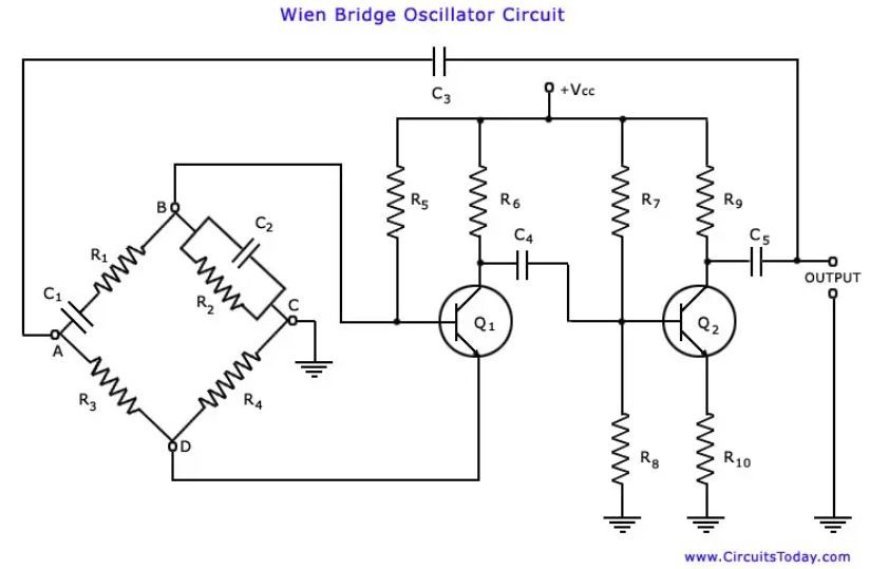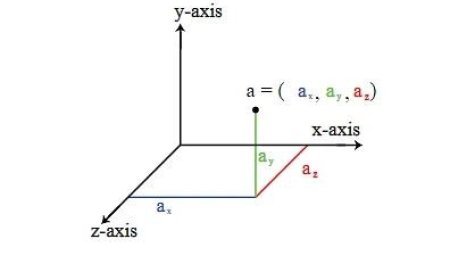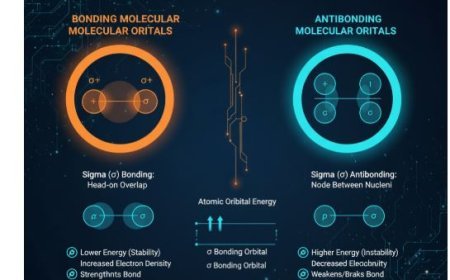WEIN BRIDGE OSCILLATOR
Wien bridge oscillator: A simple circuit that generates precise sine waves using a balanced RC network.Its adjustable resistors and capacitors control the output frequency.

WIEN BRIDGE OSCILLATOR
- A Wein bridge oscillator is a type of oscillator that contributes to the generation of sine waves as an output.
- The Wein bridge oscillator can create a wide variety of frequencies. This entire system is built on the bridge circuit, which is made up of two capacitors and four resistors.
- The Wien bridge oscillator takes its name from the name of Max Karl Wien, a prominent physicist. In 1890, the Wien bridge oscillator was invented.
WIEN BRIDGE OSCILLATOR CIRCUIT DIAGRAM
Let's talk about how to build the Wein bridge oscillator.
- A resistor-capacitor (RC) circuit is used in the Wein bridge oscillator, which is a two-stage amplifier.
- In this bridge, the capacitor C1 is connected in series with the resistors R1 and R3, while the resistor R2 is connected in parallel with the capacitor C2.
- A tungsten lamp (Lp) is connected in parallel with the resistor R1.
- As a stabilizer, we use the resistors Lp and R3. This will aid in maintaining the output's amplitude.
- Two transistors, Q1 and Q2, were utilized. Q1 and Q2 both have a 360-degree phase.
- The first transistor, Q1, functions as an amplifier as well as an oscillator. Q2, on the other hand, functions as an inverter.
- In this schematic, the transistor, Q1, receives positive feedback from the series and parallel circuits, R1C1 and C2R2.
- The voltage divider provides negative feedback to the transistor Q2's input.
Wien Bridge Oscillator Operation
The Wien Bridge Oscillator works as follows:
- When a current runs through the Vcc, the bridge circuits begin to oscillate, utilizing the capacitor and resistor.
- A 360-degree phase shift is used to maintain correct positive feedback between the two transistors.
- Negative feedback guarantees that the circuit's output remains consistent. The lamp (Lp) and resistor (R3) aid in achieving negative feedback in the circuit.
- The Wien bridge oscillator is a type of oscillator based on sine waves.
- The first transistor flips the input sine wave 180 degrees, converting it to a cosine wave.
- However, the second transistor spins the cosine wave 180 degrees and converts it to a sine wave for output.
- If the current in the bridge increases during feedback circulation, it indicates that negative feedback is more prevalent.
- A tungsten bulb and resistors are used to keep the current from overflowing. As a result, we will obtain the original value via the output.
Applications of Wien Bridge Oscillators
The following are some of the most important uses for Wien Bridge oscillators:
- Creating frequencies in audio and RF circuits
- Signal testing and calibration
- Sine wave output function generators
- Phase-locked loop (PLL) circuits
- Medical instrumentation
- Tone generators and other audio devices
The Benefits of the Wien Bridge Oscillator
- We have now covered practically everything. Let us now look at some of the benefits of the Wien bridge oscillator.
- The Wien bridge oscillator provides the signals for filter testing.
- It has a high current output due to the presence of two transistors that amplify the current twice as rapidly.
- The Wien bridge oscillator has good frequency stability.
- Using the potentiometer, we may adjust the frequency of oscillation at any time.
- The Wien bridge oscillator generates a nice sine wave that is less distorted.
Wien Bridge Oscillator Drawbacks
- If anything has advantages, it must also have disadvantages. Let us go over some of the disadvantages of employing the Wien bridge oscillator.
- The Wien bridge oscillator requires a large number of tools, which are not always available.
- Because of the two transistors and several additional components, the circuit is complicated.
- The Wien bridge oscillator is incapable of producing very high frequencies.
What's Your Reaction?



































